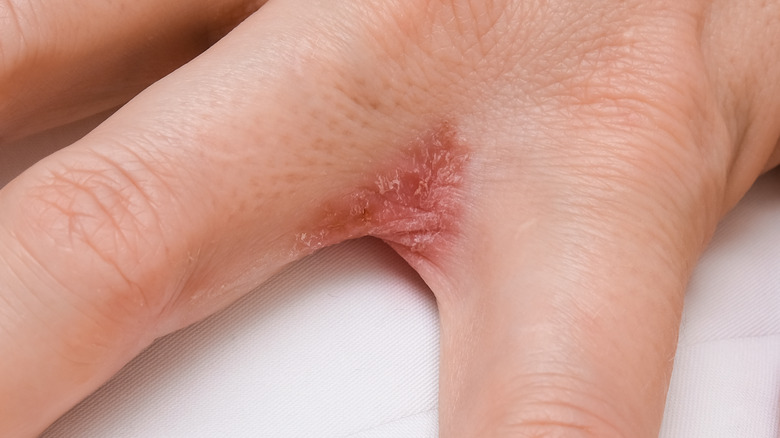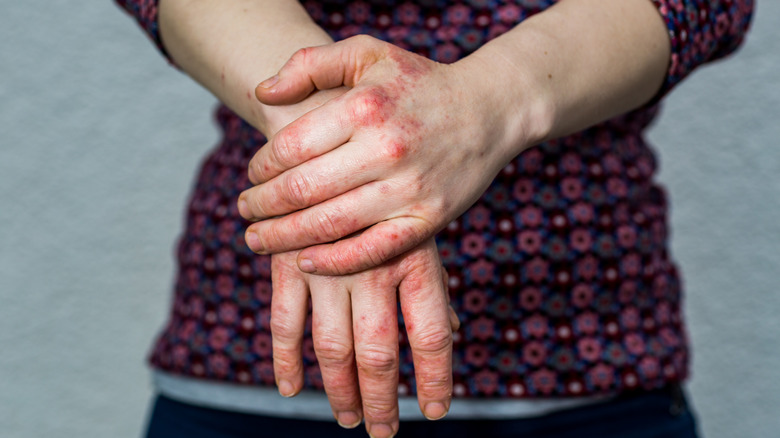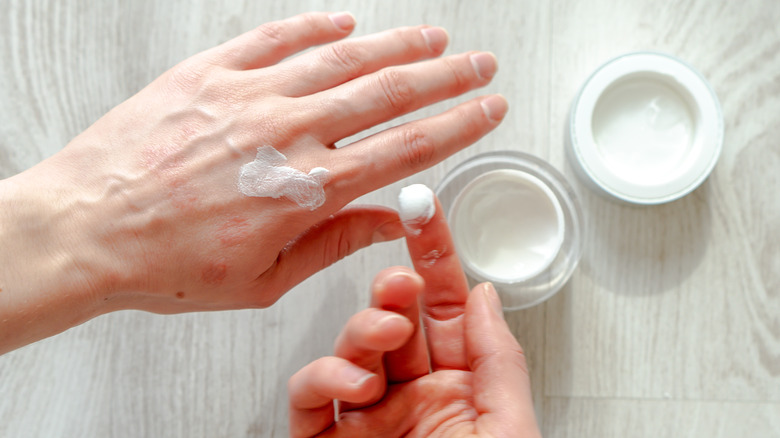Everything You Need To Know About Dyshidrosis
Dyshidrosis is also known as pompholyx or dyshidrotic eczema. It's a recurring or chronic skin condition affecting the palms, fingers, feet, and toes (via the Mayo Clinic). The rash appears as small, fluid-filled blisters, causing itching and reddened skin on the hands (and possibly feet).
Typically, the blisters disappear in a few weeks without complications before flaking off, per Healthline. The blisters will also shrink without bursting, but too much itching might cause the blisters to break. In more severe cases, the rash can spread, and the individual blisters can join together to form larger blisters. With these symptoms, the disease is referred to as pompholyx, per Science Direct. The primary cause of complications is discomfort from itching and pain. You also risk a bacterial infection on the skin if you itch the blisters too much, per Healthline.
As the causes are unknown, understanding the best preventative measures isn't always straightforward. Seeking the help of a dermatologist is the best way to further understand your individual condition.
Main causes of dyshidrosis
As mentioned, the exact causes of dyshidrosis aren't known. There are only indications and assumptions as to what triggers a breakout. Therefore, a dermatologist must ultimately decide on the therapy for those affected in each individual case.
However, some things can be linked to dyshidrosis. As noted, dyshidrosis is a skin disease associated with eczema. This why the alternative name is called dyshidrotic eczema. About half of all patients with dyshidrosis also suffer from atopic eczema (via WebMD). Furthermore, skin diseases with eczema are usually referred to as dermatitis. This is why dyshidrotic is often called dyshidrotic dermatitis.
With these indications, causes of dyshidrosis are usually associated with atopic eczema (atopic dermatitis). According to WebMD, environmental factors and emotional stress play a role in the development of dyshidrosis. Contact irritants (like nickel), allergens, humid weather, immunoglobulins, and HIV infection can all trigger the disease. The condition might also be genetic if you have a family history of eczema, per WebMD.
Treatment for dyshidrotic eczema
As with many diseases, treating dyshidrosis isn't always straightforward. Only your dermatologist can determine the exact diagnosis and treatment for the affected areas.
The correct treatment also depends on the cause of the trigger — whether the dyshidrotic eczema was triggered by a contact allergy or is a result of an underlying immune condition, like HIV. If it's caused by an allergy, your dermatologist might advise avoiding contact with the allergen (the substance that causes the allergy) to prevent eczema from recurring.
According to the Mayo Clinic, creams or ointments are usually prescribed for treatment. For more severe cases, your dermatologist might also advise taking corticosteroid pills, like prednisone (via Mayo Clinic). Long-wavelength ultraviolet light therapy is also used in more severe cases (via Medscape).
Dyshidrosis treatment with antibiotics is possible if a bacterial infection arises (via MedicalNewsToday). Furthermore, you might be prescribed an antihistamine, like diphenhydramine (Benadryl), to reduce the itching, per WebMD.



